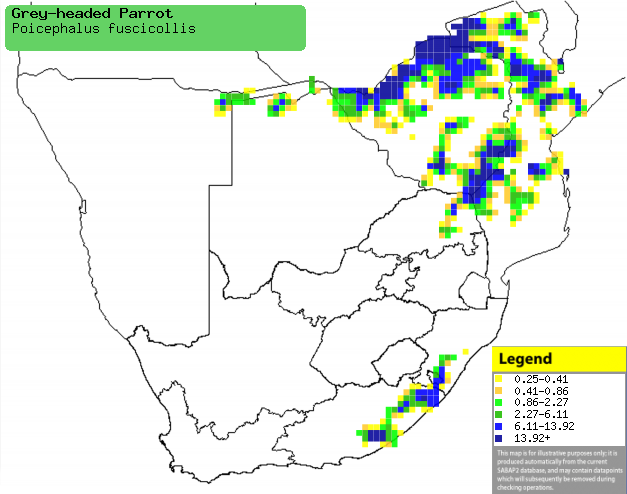|
Poicephalus fuscicollis
(Grey-headed parrot)
Savannepapegaai [Afrikaans]; Perroquet à cou brun
[French]; Graukopfpapage [German]
Life
> Eukaryotes >
Opisthokonta
> Metazoa (animals) >
Bilateria >
Deuterostomia > Chordata >
Craniata > Vertebrata (vertebrates) > Gnathostomata (jawed
vertebrates) > Teleostomi (teleost fish) > Osteichthyes (bony fish) > Class:
Sarcopterygii (lobe-finned
fish) > Stegocephalia (terrestrial
vertebrates) > Tetrapoda
(four-legged vertebrates) > Reptiliomorpha > Amniota >
Reptilia (reptiles) >
Romeriida > Diapsida > Archosauromorpha > Archosauria >
Dinosauria
(dinosaurs) > Saurischia > Theropoda (bipedal predatory dinosaurs) >
Coelurosauria > Maniraptora > Aves
(birds) >
Order: Psittaciformes > Family: Psittacidae
The Grey-headed parrot is uncommon yet widespread, occupying
an area from Tanzania to Zimbabwe. It occurs in a variety of woodland habitats,
including Miombo. Mopane and riparian woodland, feeding almost exclusively on
fruit. It nests in natural tree cavities, usually in the trunk or in the
underside of a branch. Here it lays 2-4 eggs, which are incubated solely by the
female for 28-30 days. The male contributes by providing food for the female and
chicks. They learn to fly when they are about 68-83 days old, only becoming
fully independent 4-5 months later.
Distribution and habitat
Occurs from southern DRC and Tanzania to Zambia, Angola,
Malawi to southern Africa, where it is uncommon in the Caprivi Strip (Namibia),
northern Botswana, Zimbabwe, Mozambique, Limpopo Province and south-eastern
South Africa. It generally prefers woodland habitats, such as Mopane (Colosphermum
mopane), miombo (Brachystegia) and riparian
woodland.
|
 |
|
Distribution of Grey-headed parrot in southern Africa,
based on statistical smoothing of the records from first SA Bird Atlas
Project (©
Animal Demography unit, University of
Cape Town; smoothing by Birgit Erni and Francesca Little). Colours range
from dark blue (most common) through to yellow (least common).
See here for the latest distribution
from the SABAP2. |
Food
It almost exclusively eats fruit,
mainly foraging in the upper tree canopy, using its bill to scale up
branches. The following food items have been recorded in it's diet:
- Fruit
- Sclerocarya birrea (Marula)
- Psaudolachnostylis maprouneifolia (Kudu-berry)
- Commiphora mollis (Velvet-leaved corkwood)
- Xanthocercis zambesiaca (Nyala-tree)
- Terminalia (cluster-leafs)
- Gmelina arborea (White teak)
Breeding
- It nests in natural tree cavities, usually in the
trunk or the underside of a branch.
- Egg-laying season is from March-June.
- It lays 2-4 eggs, which are incubated solely by the female for 28-30
days. The male helps out by bringing food to the female.
- During the nestling period the male does most of the foraging, while the female broods and cares for the chicks. They learn to fly when
they are about 68-83 days old, becoming fully independent 4-5 months
later.
Threats
Not threatened, however its population has decreased in
southern Africa recently, probably due to habitat loss and food shortage.
References
-
Hockey PAR, Dean WRJ and Ryan PG (eds) 2005. Roberts
- Birds of southern Africa, VIIth ed. The Trustees of the John Voelcker
Bird Book Fund, Cape Town.
|
